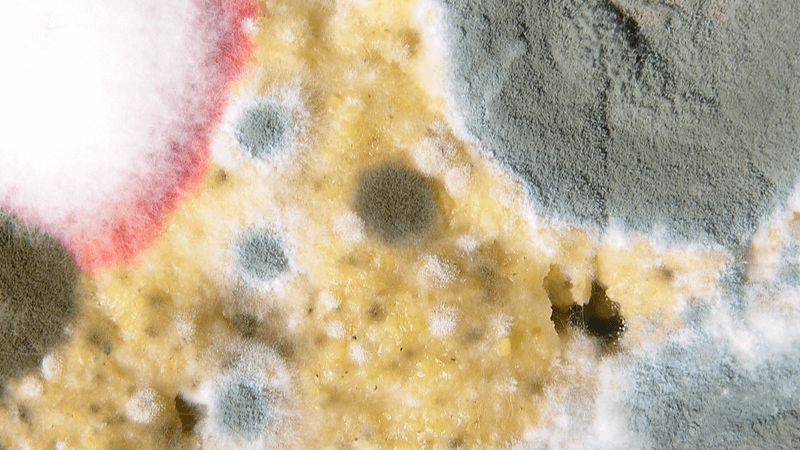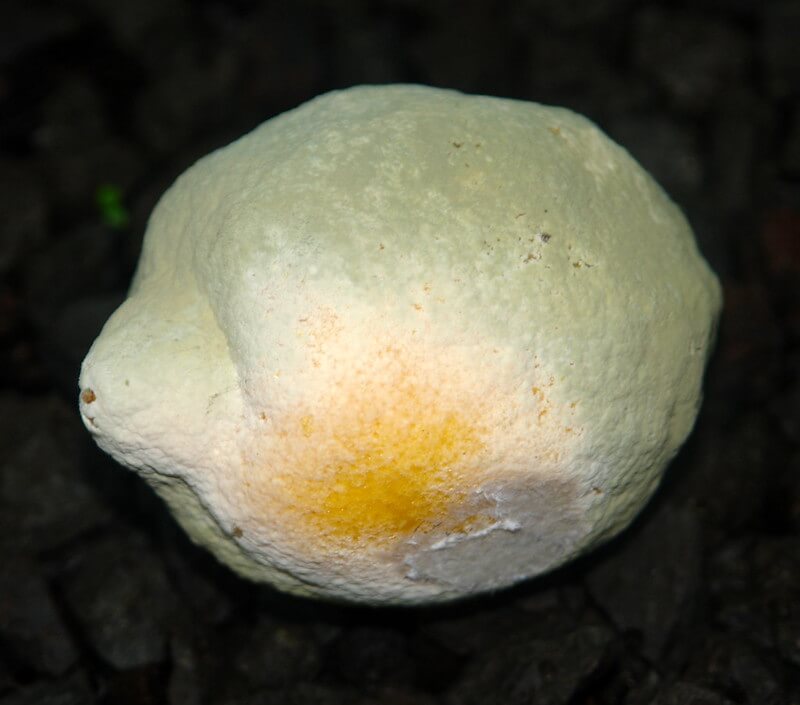Mold are microscopic organisms that grow both indoors and outdoors. Indoors, mold is one of those inevitable things homeowners must deal with.
All types of mold have one thing in common – they thrive and love moisture. If you suspect a mold problem in your home, then high humidity should be one of your suspects. You can inest in a dehumidifier or check out our best mold killing primers.
Mold comes in all colors, sizes, and shapes. Accurate identification of mold with the naked eye is impossible. However, based on the color and nature of occurrence, you can narrow it down to the type of mold in your home. Here are the common types of mold in homes.
1. Alternaria
Classification: Allergenic mold
Color: Brownish
Location: Carpets, wallpaper, window frames
Dangers: Allergies, visual impairment,
Common in temperate climatic areas, Alternaria mold can be spotted outdoors from spring to late fall. Alternaria currently has 40-50 known species. Most of these species are saprobic, meaning they are mostly involved in the decomposition of organic matter.
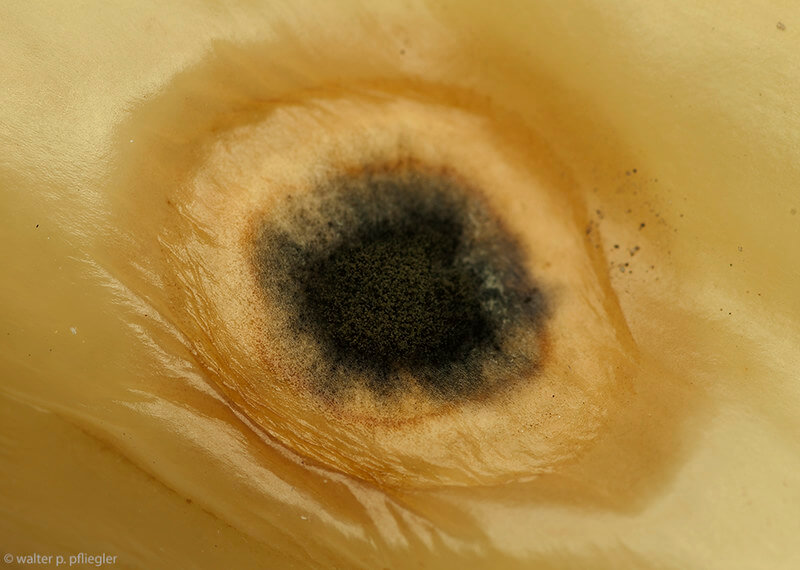
Most Alternaria mold species can be found in environments with moisture and organic materials. Some examples of Alternaria include A. alternariae, A. botrytis, A. leptinellae, A. oudemansii, and A. scirpinfestas.
As an allergenic mold, Alternariae causes external and internal infections in people. External diseases affect the skin and other parts like nails and cornea, resulting in visual impairment and various sinuses. However, most of the infections are on the skin surface. Continuous inhalation of this mold is also known to cause induction of allergic rhinitis, according to Mashdad University, Department of Medical Mycoparasitology.
2. Aspergillus
Classification: Allergenic/ Toxigenic mold
Color: It comes in different colors. However, common colors include yellow-green and blue-green.
Location: Carpets and mattresses, kitchen & bathroom, basements, damp walls
Dangers: ABPA, aspergilloma
With over 200 species, Aspergillus mold widely occurs from the arctic to the tropical regions. This mold is found in plant debris, soil, and indoor air environments. The spores are flask-shaped and can form thick layers or long chains on surfaces.

The concentration of Aspergillus spores in the air we breathe is high, but it usually does not cause illness. However, in people with weak immune systems, it is known to cause allergies, damaged lungs, ABPA, CPA, and aspergilloma. Asthma patients can also develop complications when exposed to aspergillus spores.
3. Aureobasidium
Classification: Allergenic mold
Color: Pink, brown, or black
Location: Behind wallpapers, on damp painted surfaces, humidifier water, laundry room
Dangers: Deteriorate paint, phaeohyphomycosis, allergies
With over 15 species and varieties, Aureobasidium mold is prevalent indoors in damp and moist areas. Depending on the location of the mold and how old it is, The color of Aureobasidium ranges from pink and, over time, gets darker. The four major types of Aureobasidium are A. pullulans, A. subglaciale, A. melanogenum, and A. namibiae.
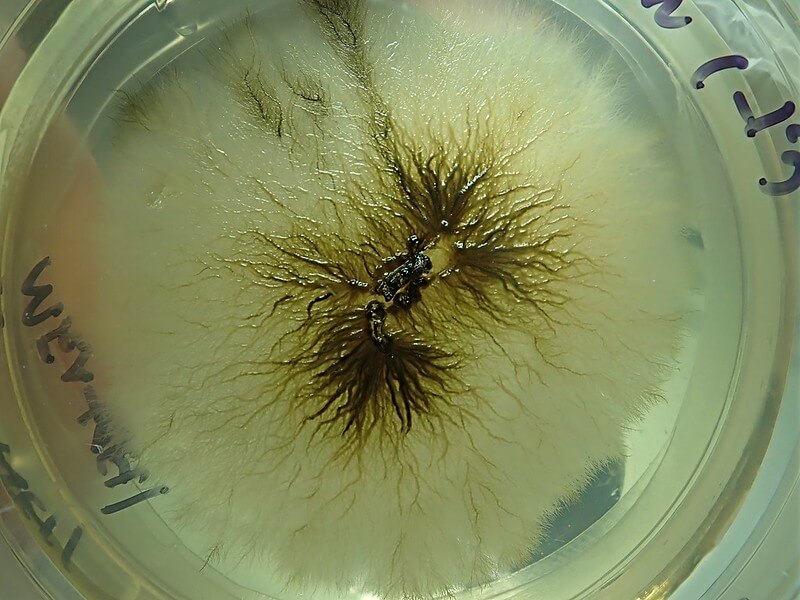
The most common species of Aureobasidium, A. pullulans, is known to cause allergic reactions like hay fever, humidifier fever, and asthma. It is also known to cause phaeohyphomycosis.
In case a person inhales Aureobasidium spore in large numbers, they could form a colony in a person’s lungs. This can cause hypersensitivity pneumonitis or ‘humidifier lung.’ Apart from the lungs, Aureobasidium can also affect other internal organs like kidneys, spleen, or prosthetic hips.
4. Chaetomium
Classification: Allergenic/ Pathogenic mold
Color: Begins as white and eventually darkens. gray>brown>black
Location: On wallpapers, wet drywall, damp books, and other cellulose-based materials
Dangers: cause book and cellulose-based materials to deteriorate
There are over 75 species of Chaetomium known to occur. The most common species of this mold are Chaetomium atrobrunneum, C. globosum, C. funicola, and C. murorum. In indoor environments, the most common species is C. globosum.
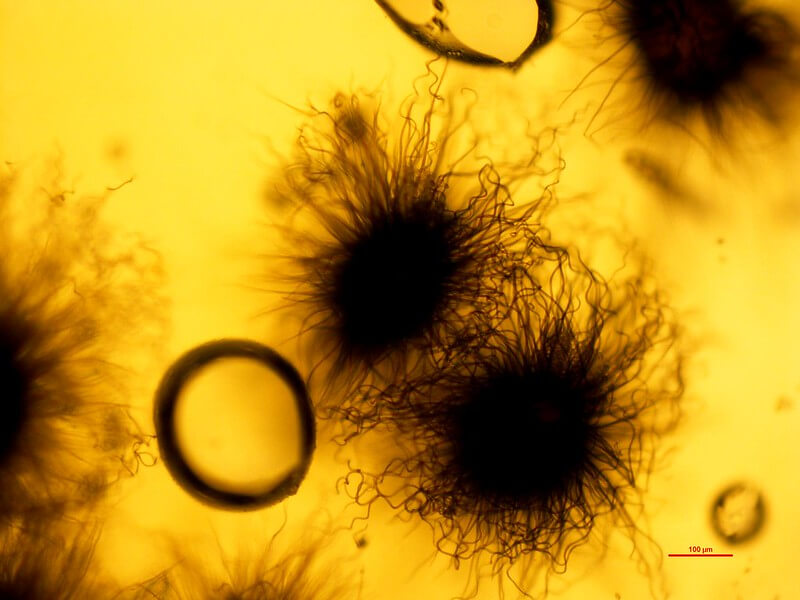
However, the concentration of chaetomiumium is deficient in indoor air. This is because the spores are covered in a flask-shaped body that keeps them from being readily exposed to the air. Because of the very low concentration in the air, the presence of chaetomium in your home indicates an existing or previous serious moisture problem.
Chaetomium globosum is a widespread species found on wallpapers, carpets, window frames, and wet drywall. Because of its bio-deterioration ability, this species has caused problems in the food industry and library archives. In libraries, it causes biodeterioration of paper. However, it can also cause the biodeterioration of other cellulose-containing materials.
Exposure to Chaetomium in humans is not well documented. However, it is considered a dangerous type of mold.
5. Cladosporium
Classification: Allergenic mold
Color: Black, brown, or green
Location: HVAC fans, foodstuffs, paint and textile, mattress dust, carpet
Dangers: causes allergenic reactions in low immunity patients
Cladosporium is a mold that is both found indoors and outdoors. It is often found on plants, decaying organic material, and soil in the outdoor setting. Indoors, Cladosporium can be found on wet building materials, carpet and mattress dust, wallpaper, and HVAC fans. Though high humidity contributes to the growth and faster spread of this type of mold, other factors like poor ventilation and dark surfaces also accelerate its growth and spread.
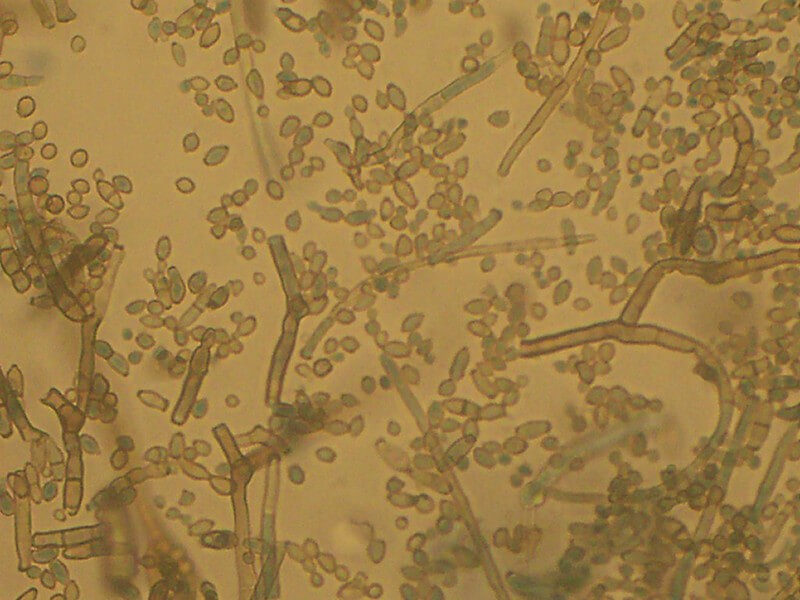
According to a study by Bensch K, Groenewald J, Meijer M, et al., a survey conducted in indoor environments isolated over 520 new Cladosporium species. The four main species are c. herbarum, C. sphaerospermum, C. cladosporioides, and C. macrocarpum.
In humans, Cladosporium is a well-known trigger for asthmatic attacks. In patients with compromised immunity, Cladosporium will cause Other allergenic reactions like sneezing, coughing, difficulty breathing, headache, wheezing, sore throat, sinus congestion, and watery eyes.
6. Fusarium
Classification: Allergenic/ Pathogenic mold
Color: Pink, white or red
Location: wet & water stagnant areas, mattress and carpet dust, foodstuffs
Dangers: Brain abscess, osteomyelitis, cystitis, septic arthritis
Fusarium, like Cladosporium, is a very common type of mold that can be found everywhere. Outdoor, it can be found on plants and soil. In plants, Fusarium is known to cause wilting of many crops, including tomatoes, sweet potatoes, bananas, pears, and pigeon peas.
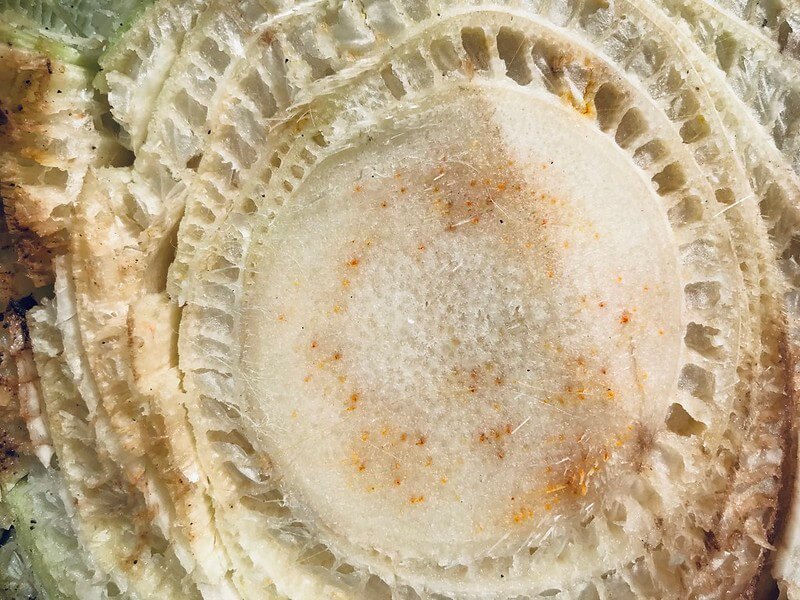
Indoors, Fusarium can thrive under very wet conditions, particularly those that have suffered water damage. Common areas to check out for this mold are humidifier pans, damp walls, areas where stagnant water occurs in HVAC systems, wallpapers, mattresses, and carpet dust.
Fusarium currently has over 20 species. The most common are F. solani, F. culmorum, F. oxysporum, and F. chlamydosporum.
Healthwise, Fusarium can cause mycotoxicosis in humans following the ingestion of food that contains the mold. Airborne, Fusarium generally affects people with low immunity. Suppose the fungus enters your body by breaking the skin or tissues. In that case, it might cause severe infections and life-threatening conditions like Brain abscess, osteomyrlitis, cystitis, and septic arthritis.
7. Geotrichum
Classification: Allergenic/ Pathogenic mold
Color: White
Location: Sewage effluents, water, foodstuffs, damp walls
Dangers: Geotrichosis infections, major barrier breaks in people with compromised immunity.
Geotrichum is Commonly found in polluted water, paper pulp, sewage effluents, and textiles. It is also widely found as spoilage of foodstuffs such as meat, fruits, bread, etc. Geotrichum mold includes several species, but the most common ones in homes are Geotrichum candidum, Geotrichum clavatum, and Geotrichum fici.

The Geotrichum mold occurs in white color and has a powdery to cottony look. In favorable conditions, Geotrichum can rapidly spread around your home. When disturbed on the surface, colonies of Geotrichum mold become yeast-like or slimy.
To human health, Geotrichum (Candidum) has been linked to causing pulmonary infections, oral, bronchial, vaginal, and alimentary infections. Geotrichum is also a colonizer of the human intestinal tract. It may cause geotrichosis infections in immunocompromised people. It can also pose other health risks related to major barrier breaks like peritoneal, major surgery, and corneal perforation in people with weak immune systems.
8. Memnoniella
Classification: Allergenic mold
Color: Black/greenish
Location: Cellulose-based materials and damp areas
Dangers: Allergies and affects low immunity persons
With the different types of mold found in the kingdom of fundi, Memnoniella mold closely resembles the Stachybotrys mold. The two types of mold are generally found together, are considered toxic, and have similar allergic symptoms in humans.
Memnoniella echinata, a species of Memnoniella, used to be called Stachybotrys chartarum. Apart from being smaller in size, the other noticeable difference between these two fungi is that Memnoniella produces spores in chains while Stachybotrys produces spores in mass.
Though debate among mycologists about these two fungi is yet to end, Memnoniella currently has 19 species under its name. The most commonly occurring and well-known species is Memnoniella echinata. Outdoors it is widely found in soil. In homes, it is commonly found in materials that contain cellulose, such as wallpaper, wood, textiles, paper, and drywall. You can identify Memnoniella echinata by its black or greenish thread-like appearance.
Like black mold, Memnoniella echinata also produces mycotoxins that can make people ill. Although its effects on human health are not well known, it can seriously affect people with weak immunity, people with asthma, and persons suffering from common allergies. Little is known about the severe health implications of Memnoniella echinata. However, because it produces many toxins similar to Stachybotrys, it should also be considered dangerous.
9. Mucor
Classification: Allergenic mold
Color: Initially white, then yellow, and finally gray
Location: Household dust, mattress, and carpet dust
Dangers: mucormycosis
Mucor is a fast-growing mold compared to other strains. The mold has a fluffy, cottony, or filamentous texture. When growing, it is initially white. However, as time passes, it changes to yellow and later gray. There are about 50 occurring Mucor species described worldwide. The most common species are Mucor hiemalis, Mucor plumbeus, Mucor racemosus, Mucor indicus, and Mucor amphibiorum.
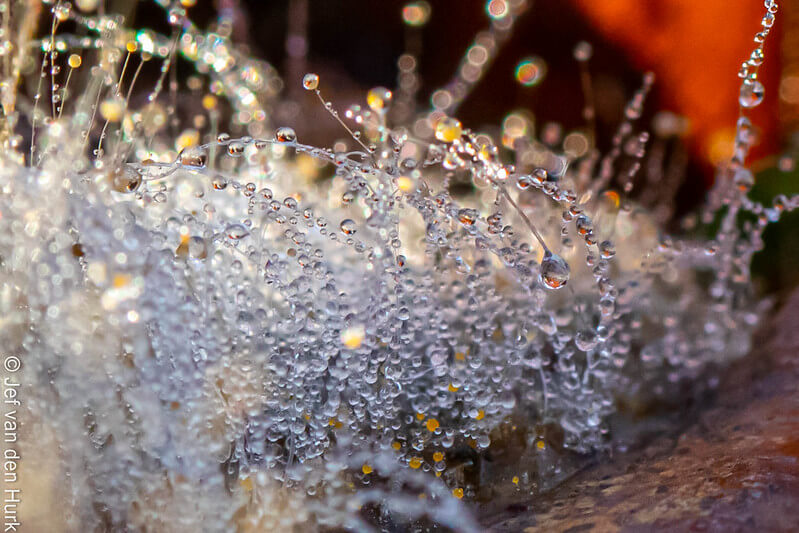
Species of Mucor can be found in soil, plants, vegetables, and decaying fruits, and they are a common contaminant of processed and stored foods in the kitchen. In homes, Mucor spores have been isolated in carpets, mattresses, and household dust.
To humans, Mucor can cause a wide range of diseases. Collectively, illnesses caused by Mucor, along with several other fungi in the Mucorales genera, are called mucormycosis. The common underlying conditions under mucormycosis include deep sores, kidney infections, sinus pain, and more. Fortunately, mucormycosis is not a common infection.
Mucor species that cause infections are thermotolerant. This means they can grow at high temperatures of over 37°C. However, very few species of Mucor can survive over 37°C.
10. Penicillium
Classification: Allergenic mold
Color: Bluish or greenish
Location: Foodstuffs, damp areas
Dangers: Food spoiler, allergies, opportunistic infections
Ever since the discovery of Penicillins in 1928 by Alexander Fleming, Penicillium has had a long history with man. Though it has been beneficial, it also comes with its share of problems.
Penicillium is found worldwide. In the soil and air and currently has over 200 species. It is widespread and has a wide range of habitats. Penicillium can be identified in homes by its musty odor or color. It usually occurs in bluish or greenish molds. It thrives in damp areas and can be found on walls, wallpaper, mattresses, carpet, and upholstered furniture dust.
Penicillium’s notable species is P. chrysogenum, which produces penicillin, and has saved countless lives as an antibiotic. Penicillium has also been used to produce blue cheese, improve the flavor of some types of sausages and hams, and produce important biotechnology-produced macromolecules and enzymes.
Outside Penicillium’s beneficial purposes, it is best known as an agent of food spoilage. This is because most Penicillium species thrive on biodegradable organic matter. Food products like sandwiches, fruits, meat, cereals, and other animal and agricultural produce are likely to be affected when stored improperly.
The Penicillium mold is also airborne and, when inhaled, causes allergies and has also been reported to cause opportunistic infections in people with weakened immune systems.
11. Stachybotrys
Classification: Toxigenic/Allergenic mold
Color: Greenish, but mostly black
Location: Cellulose-based materials like wood, drywall, fiberboards, etc
Dangers: Hemorrhage, nausea, mental impairment, and in extreme cases, death
Stachybotrys mold is one of the most commonly recognized types of mold found in the indoor environment. The mold, which has a greenish but mostly black color, is often called “black mold.” However, you should not classify every black mold as Stachybotrys. Other molds that appear black, like Memnoniella and most, are relatively harmless.
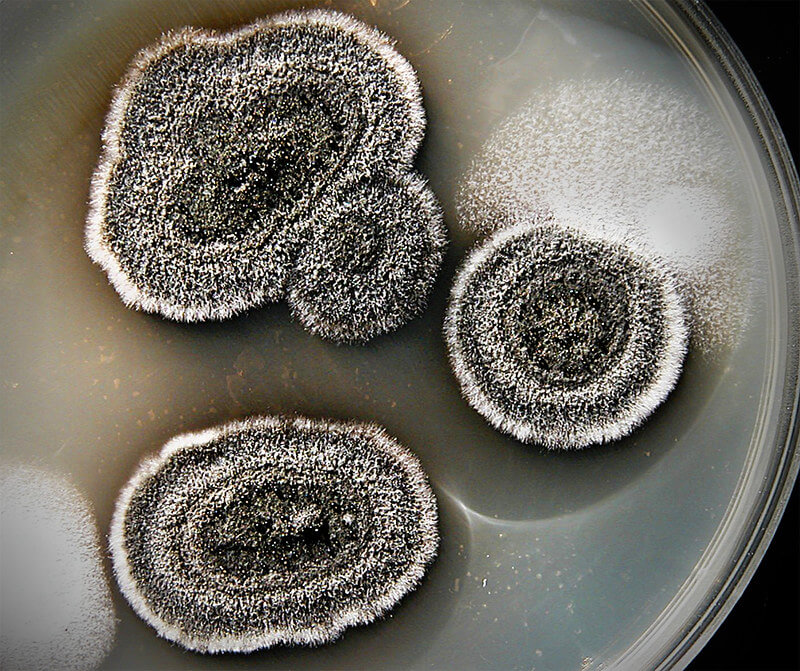
Stachybotrys commonly grow on cellulose materials. You can find it in soil and cellulose-rich materials like cereal grains, wood pulp, cotton, paper, hay, and straw. Indoors, Stachybotrys grows on fiberboards, drywall, gypsum board, and wood. There are over 70 accepted species of Stachybotrys. In homes, Stachybotrys chartarum is the common and most likely to occur.
Stachybotrys Chartarum is among the most feared indoor molds. In 1993-1994, an outbreak in Cleaveland, Ohio, of infant pulmonary hemorrhage was associated with Stachybotrys Chartarum. According to the CDC, this resulted in the death of one infant.
Stachybotrys Chartarum is known to produce several mycotoxins that cause people and animals to suffer toxic symptoms. stachybotryotoxicosis is the name given to disorders caused by Stachybotrys chartarum. Symptoms in humans affected by Stachybotrys Chartarum include damage to internal organs, bleeding, mental impairment, nausea, irritation of mucous membranes, and immune system suppression.
In extreme cases, toxic black mold can even lead to death. Because of this, it is important to take steps and remove it immediately once it is spotted.
12. Trichoderma
Classification: Allergenic mold
Color: white/ cream colonies and later Green when mature
Location: Water-ridden spots like bathrooms and cellulose-based materials
Dangers: Cause wood rotting and spoilage of various fruits and vegetables
Trichoderma is one of the most common mold species. It is widespread and can be found in soil, forests, paper, and wood. Like Penicillium mold, Trichoderma is also a unique strain of mold. It has applications in the fields of agriculture and biotechnology because it helps in fighting many plant pathogens. However, this does not mean Trichoderma growing in your home will be beneficial. Like all molds, it can damage your home and make you sick.
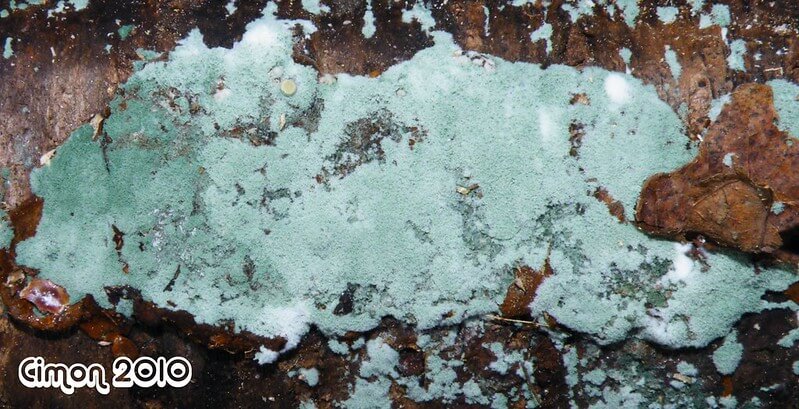
Trichoderma comprises over 89 accepted species. The most common include Trichoderma harzianum, Trichoderma viride, Trichoderma longibrachiatum, and Trichoderma reesei. Trichoderma mold is typically white or cream but over time changes to green because of sporulation.
In homes, Trichoderma mold can be found mainly on cellulose-based products like drywall, wood, paper products, and various textile. Unlike other mold species found in homes, Trichoderma requires more water. So, you will likely find this species in households with significant water damage like high moisture areas like laundry rooms, bathrooms, and kitchens. It is also found on air conditioner filters and ducts because of water condensation.
Disease and human infection by Trichoderma species are not well documented. However, it may cause opportunistic infections in people with low immunity.
13. Ulocladium
Classification: Allergenic mold
Color: Gray. brown or greenish-black
Location: very damp spots like bathrooms, kitchen, etc
Dangers: Cause hay fever-like symptoms
Ulocladium mold has only two known species. They include Ulocladium chartarum, commonly found indoors, and Ulocladium botrytis, known for its pathogenic characteristics. Ulocladium may appear in gray, brown, and greenish-black colors. Ulocladium has a cotton or wool-like texture and can be easily dispersed through the air.
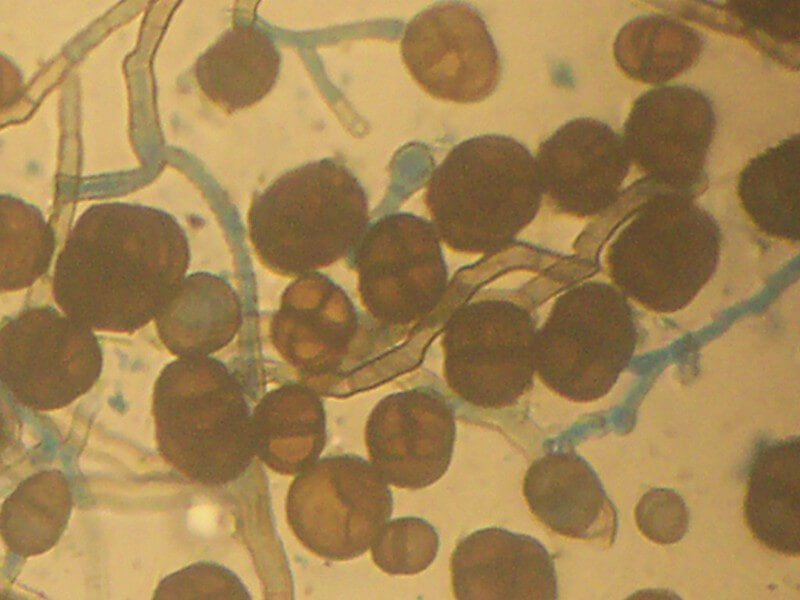
Ulocladium is a fast-growing mold. To reach maturity and start producing spores it can take about five days. This mold, like Trichoderma, best thrives in very damp areas. The presence of Ulocladium in your home is the best indicator of water damage. Bathrooms, kitchens, and basements are some of the best spots to look out for Ulocladium mold.
Ulocladium is mostly spread in the air and can easily be inhaled. In humans, Ulocladium is likely to affect people with low immunity, like patients undergoing chemotherapy, those who have HIV/AIDs, and those that have undergone organ transplants. The mold can cause hay fever-like symptoms like sneezing, headaches, coughing, itching, sinus congestion, and watery eyes.

